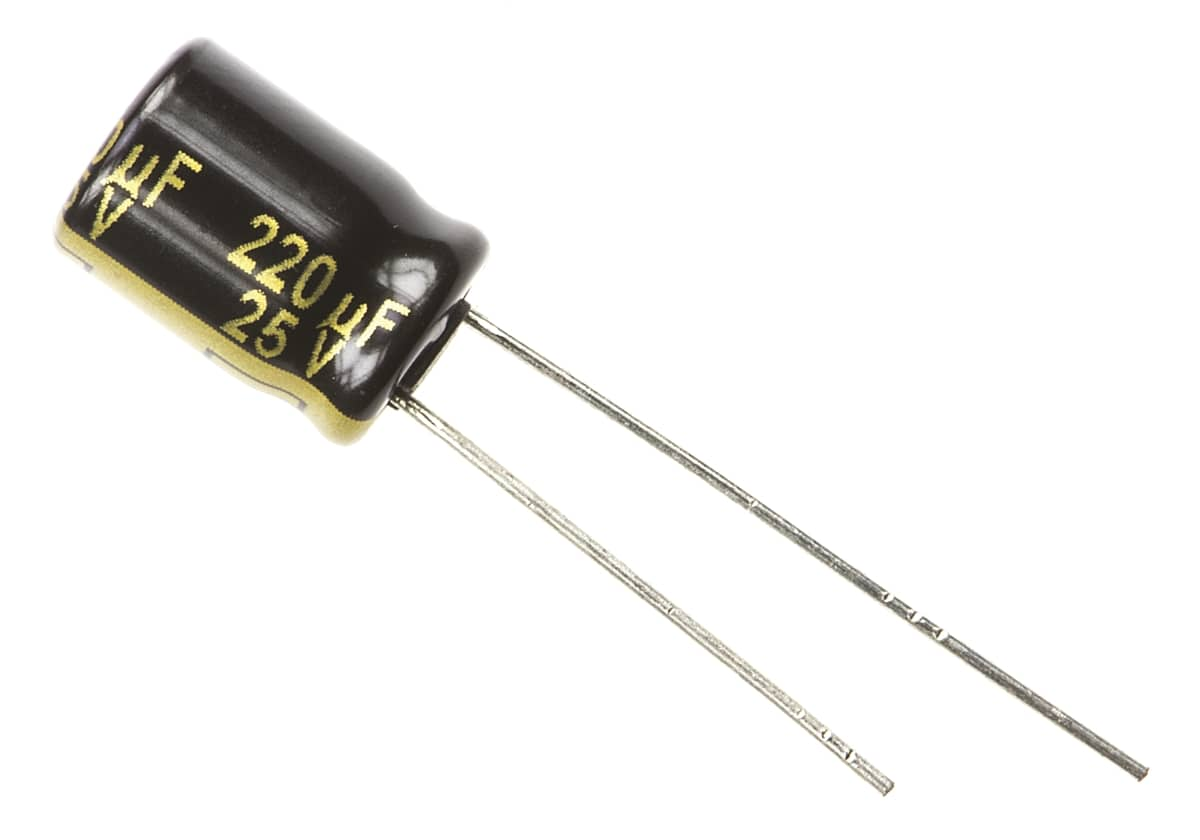Panasonic 120μF Surface Mount Polymer Capacitor, 10V dc
- RS Stock No.:
- 795-5162P
- Mfr. Part No.:
- 10SVPC120M
- Brand:
- Panasonic

Subtotal 5 units (supplied on a continuous strip)*
£3.49
(exc. VAT)
£4.19
(inc. VAT)
FREE delivery for orders over £50.00
In Stock
- 1,950 unit(s) ready to ship
- Plus 2,000 unit(s) shipping from 24 November 2025
Need more? Click ‘Check delivery dates’ to find extra stock and lead times.
Units | Per unit |
|---|---|
| 5 + | £0.698 |
*price indicative
- RS Stock No.:
- 795-5162P
- Mfr. Part No.:
- 10SVPC120M
- Brand:
- Panasonic
Specifications
Technical Reference
Legislation and Compliance
Product Details
Find similar products by selecting one or more attributes.
Select all | Attribute | Value |
|---|---|---|
| Brand | Panasonic | |
| Technology | Polymer | |
| Capacitance | 120µF | |
| Voltage | 10V dc | |
| Mounting Type | Surface Mount | |
| Equivalent Series Resistance | 27mΩ | |
| Lead Pitch | 2.1mm | |
| Tolerance | ±20% | |
| Length | 5.9mm | |
| Maximum Operating Temperature | +105°C | |
| Height | 5.9mm | |
| Dimensions | 6.3 (Dia) x 5.9mm | |
| Series | SVPC | |
| Electrolyte Type | Solid | |
| Polarised | Polar | |
| Minimum Operating Temperature | -55°C | |
| Ripple Current | 2.32A | |
| Leakage Current | 300 μA | |
| Lifetime | 2000h | |
| Diameter | 6.3mm | |
| Dissipation Factor | 12% | |
Select all | ||
|---|---|---|
Brand Panasonic | ||
Technology Polymer | ||
Capacitance 120µF | ||
Voltage 10V dc | ||
Mounting Type Surface Mount | ||
Equivalent Series Resistance 27mΩ | ||
Lead Pitch 2.1mm | ||
Tolerance ±20% | ||
Length 5.9mm | ||
Maximum Operating Temperature +105°C | ||
Height 5.9mm | ||
Dimensions 6.3 (Dia) x 5.9mm | ||
Series SVPC | ||
Electrolyte Type Solid | ||
Polarised Polar | ||
Minimum Operating Temperature -55°C | ||
Ripple Current 2.32A | ||
Leakage Current 300 μA | ||
Lifetime 2000h | ||
Diameter 6.3mm | ||
Dissipation Factor 12% | ||
- COO (Country of Origin):
- JP
Panasonic SVPC Series Polymer Capacitor, 120μF Capacitance, 10V DC Voltage - 10SVPC120M
This polymer capacitor is designed for surface mounting, providing robust performance in electronic applications. With a capacitance of 120 μF and an operating voltage of 10V DC, it maintains stability across a range of conditions. Its compact dimensions of 6.3mm in diameter and 5.9mm in height ensure it fits snugly onto circuit boards, making it a versatile choice for various devices.
Features & Benefits
• Solid electrolyte technology enhances reliability and performance
• Low equivalent series resistance of 27 mΩ improves efficiency
• Wide operational temperature range from -55°C to +105°C
• Tolerance of ±20% ensures reliable performance under varying conditions
• Minimal leakage current of 300 μA supports long-term operation
• Designed for surface mounting to optimise space on PCBs
• Low equivalent series resistance of 27 mΩ improves efficiency
• Wide operational temperature range from -55°C to +105°C
• Tolerance of ±20% ensures reliable performance under varying conditions
• Minimal leakage current of 300 μA supports long-term operation
• Designed for surface mounting to optimise space on PCBs
Applications
• Used in automation systems for efficient electronic control
• Ideal for circuit design in consumer electronics
• Suitable for power supply systems requiring stable capacitance
• Utilised in mechanical devices needing compact, reliable components
• Ideal for circuit design in consumer electronics
• Suitable for power supply systems requiring stable capacitance
• Utilised in mechanical devices needing compact, reliable components
What benefits does solid electrolyte technology provide in practical applications?
The solid electrolyte ensures increased reliability and reduces the risk of leakage, making it suitable for long-term use in various electronic circuits.
How does the low equivalent series resistance impact performance?
A low equivalent series resistance allows for improved energy efficiency, with minimal power loss during operation, enhancing the overall performance of electronic devices.
What are the implications of the wide operational temperature range for usage?
The wide temperature range enables this component to function effectively in environments that experience extreme temperatures, ensuring consistent performance across various applications.
What specific challenges can this component help address in automation systems?
Its stability under varying conditions and low leakage current make it ideal for maintaining consistent functionality in automation systems, reducing the risks of component failure.


